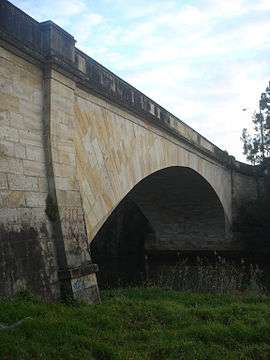Lansdowne Bridge
| Lansdowne Bridge | |
|---|---|
 Lansdowne Bridge in 2006 | |
| Coordinates | 33°53′24″S 150°58′01″E / 33.89°S 150.966944°ECoordinates: 33°53′24″S 150°58′01″E / 33.89°S 150.966944°E |
| Carries | Cars and pedestrians |
| Crosses | Prospect Creek, New South Wales |
| Named for | Henry Petty-Fitzmaurice, 3rd Marquess of Lansdowne |
| Characteristics | |
| Material | Sandstone |
| Total length | 190 feet (58 m) |
| Width | 30 feet (9.1 m) |
| Longest span | 110 feet (34 m) |
| Clearance above | 30 feet (9.1 m) |
| History | |
| Designer | David Lennox |
| Construction begin | 1 January 1834[1] |
| Construction end | 1835 |
| Opened | 26 January 1836[2] |
Lansdowne Bridge is a sandstone arch bridge located in Lansdowne, New South Wales. Designed by David Lennox in 1834 and opened in 1836, it has the largest span of any extant masonry bridge in Australia.[3]
History
In 1832, the Surveyor-General at the time, Sir Thomas Mitchell, commissioned Lennox for a sum of £1083 to build a bridge at the intersection of Prospect Creek and Southern Street,[3][4] which would replace the nearby "Bowler's Bridge" named after Lansdowne's local innkeeper.[5] The sandstone used in designing the bridge was found in a quarry only 11 kilometres (6.8 mi) from the proposed site of the bridge, allowing workers to row a punt to transport the stone to the construction site.[4] On January 1, 1834, the foundation stone was laid. The bridge was constructed entirely by unskilled Australian convicts, despite Lennox's numerous requests to Mitchell for skilled labourers.[5] The bridge was completed a year later in 1835, and opened on January 26, 1836, the 48th anniversary of the Colony of New South Wales, before a crowd of around 1,000.[3][5] Later, Richard Bourke, the Governor of New South Wales, wrote that the bridge had cost only £1000 to build, compared to the £7000 it would have taken to build a bridge of the same quality in England.[5]
Legacy
In 1973, Australia recognized Lansdowne Bridge for being "one of the finest examples of Colonial Architecture in Australia".[3] In 1990, the Environmental Management Committee Fairfield Council confirmed that Lansdowne Bridge had the largest span of all masonry bridges in Australia and in 1992 that it was an example of excellent construction, which should be preserved.[3][6] Lansdowne Bridge is also listed on the Register of the National Estate[7] and on the National Historic Engineering Landmark list.[5]
References
- ↑ "The Laytons, Female Emigrants.". The Sydney Monitor. VIII, (633). New South Wales, Australia. 3 January 1834. p. 2 (MORNING). Retrieved 11 September 2016 – via National Library of Australia.
- ↑ "The Sydney Herald.". The Sydney Herald. VI, (442). New South Wales, Australia. 21 January 1836. p. 2. Retrieved 10 September 2016 – via National Library of Australia.
Historic buildings vol III Liverpool and Campbelltown. Cumberland County Council. 1963. pp. 47–51. Retrieved 10 September 2016. - 1 2 3 4 5 "Lansdowne Bridge over Prospect Creek". New South Wales Department of Roads and Maritime. 7 July 2014. Retrieved 3 November 2015.
- 1 2 "Lansdowne Bridge". Heritage Council of New South Wales. Retrieved 3 November 2015.
- 1 2 3 4 5 "Lennox's Lansdowne Bridge" (PDF). The Institution of Engineers Australia. March 1986. Retrieved 6 November 2015.
- ↑ "Historical Archaeological Sites – Lansdowne Bridge" (PDF). Fairfield City Council. 15 July 1992. Archived from the original (PDF) on 17 November 2015. Retrieved 3 November 2015.
- ↑ Australian Heritage Commission (1981). The Heritage of Australia : the illustrated register of the National Estate. South Melbourne The Macmillan Company of Australia in association with the Australian Heritage Commission. p. 2/24. ISBN 978-0-333-33750-9.